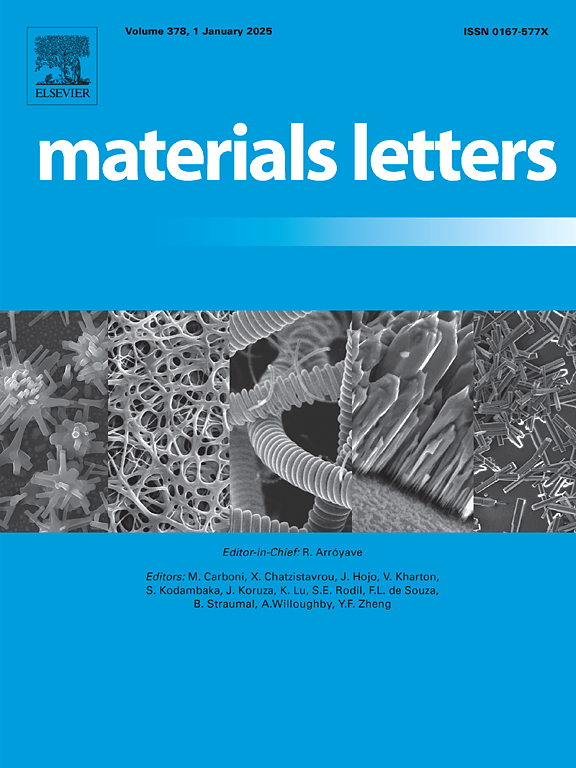通过控制双苯二腈预聚物的形态来裁剪聚芳醚腈的介电性能
IF 2.7
4区 材料科学
Q3 MATERIALS SCIENCE, MULTIDISCIPLINARY
引用次数: 0
摘要
随着电子器件向高频化、小型化方向发展,绝缘聚合物的耐压性能不足已成为其关键瓶颈。本文设计了双苯二腈(BPh)预聚物的形态梯度,以优化聚芳醚腈(PEN)的介电性能。具体而言,采用高温溶剂热法(160℃)制备了不同形貌的BPh预聚物:1 h形成片状结构,3 h形成片层-球形混合结构,6 h形成球形结构。将预聚物填充到PEN中制备复合膜后,通过固化反应制备复合膜,并对其介电性能进行了研究。结果表明:复合材料的击穿强度为343.11 kV/mm,比纯PEN的击穿强度(161.91 kV/mm)提高了111.91%;层状球形(188.36 kV/mm)和球形(238.07 kV/mm)结构分别增加了16.34%和47.03%。这意味着片状结构可以有效地分散电场,而球形结构由于曲率效应的抑制能力较弱。这项工作为高绝缘聚合物薄膜的设计提供了新的思路。本文章由计算机程序翻译,如有差异,请以英文原文为准。
Tailoring dielectric properties of poly(arylene ether nitrile) via bisphthalonitrile prepolymer morphology control
With the development of electronic devices to high frequency and miniaturization, the insufficient voltage resistance of insulating polymers has become a key bottleneck. Here, a morphological gradient of bisphthalonitrile (BPh) prepolymer was designed to optimize the dielectric properties of polyarylene ether nitrile (PEN). Specifically, BPh prepolymers with different morphologies were prepared by the high-temperature solvothermal method (160 ℃): 1 h to generate a sheet structure, 3 h to form a lamellar-spherical mixed structure, and 6 h to form a spherical structure. After the composite film was prepared by filling the prepolymer into PEN, the film was then prepared by curing reaction and its dielectric properties were investigated. Results show that breakdown strength of cured composite with sheet prepolymer is 343.11 kV/mm, which is 111.91 % higher than that of pure PEN (161.91 kV/mm). The lamellae-spherical (188.36 kV/mm) and spherical (238.07 kV/mm) structures increased by 16.34 % and 47.03 %, respectively. It means that the sheet structure can effectively disperse the electric field, while the spherical structure has a weak inhibition ability due to the curvature effect. This work provides a new idea for the design of highly insulating polymer films.
求助全文
通过发布文献求助,成功后即可免费获取论文全文。
去求助
来源期刊

Materials Letters
工程技术-材料科学:综合
CiteScore
5.60
自引率
3.30%
发文量
1948
审稿时长
50 days
期刊介绍:
Materials Letters has an open access mirror journal Materials Letters: X, sharing the same aims and scope, editorial team, submission system and rigorous peer review.
Materials Letters is dedicated to publishing novel, cutting edge reports of broad interest to the materials community. The journal provides a forum for materials scientists and engineers, physicists, and chemists to rapidly communicate on the most important topics in the field of materials.
Contributions include, but are not limited to, a variety of topics such as:
• Materials - Metals and alloys, amorphous solids, ceramics, composites, polymers, semiconductors
• Applications - Structural, opto-electronic, magnetic, medical, MEMS, sensors, smart
• Characterization - Analytical, microscopy, scanning probes, nanoscopic, optical, electrical, magnetic, acoustic, spectroscopic, diffraction
• Novel Materials - Micro and nanostructures (nanowires, nanotubes, nanoparticles), nanocomposites, thin films, superlattices, quantum dots.
• Processing - Crystal growth, thin film processing, sol-gel processing, mechanical processing, assembly, nanocrystalline processing.
• Properties - Mechanical, magnetic, optical, electrical, ferroelectric, thermal, interfacial, transport, thermodynamic
• Synthesis - Quenching, solid state, solidification, solution synthesis, vapor deposition, high pressure, explosive
 求助内容:
求助内容: 应助结果提醒方式:
应助结果提醒方式:


